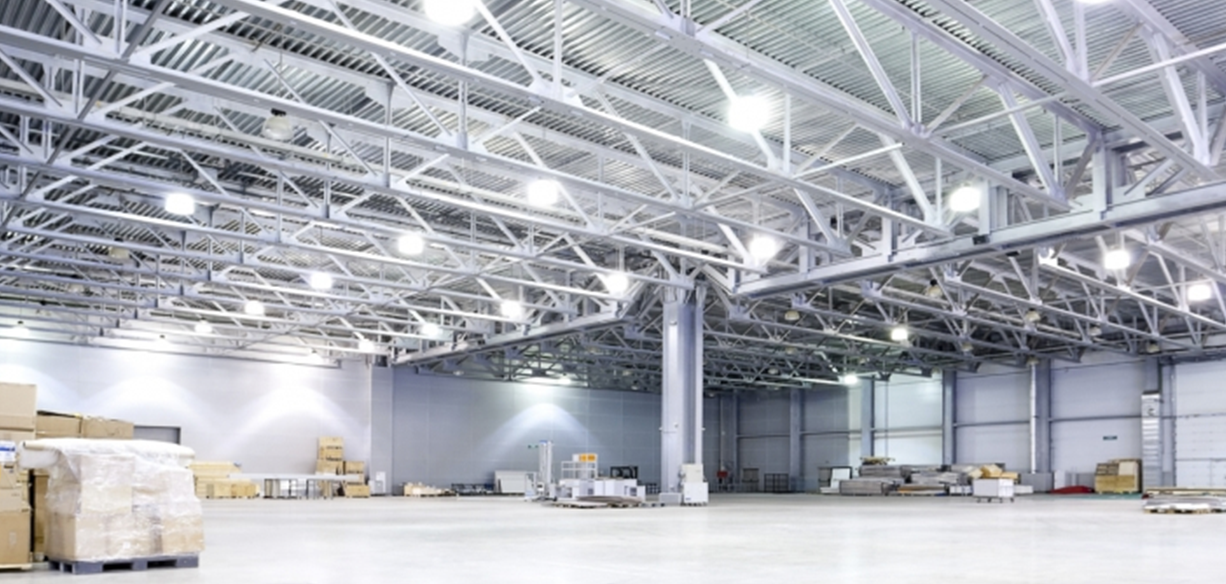
Fluorescent Lighting
What is a "Fluorescent Light" application?
Fluorescent lamps are a lamp type that is commonly used to provide illumination for settings such as commercial lighting, industrial lighting, classroom lighting, and retail lighting. The sizes, light colors, and wattage of fluorescent tubes vary significantly. The most common attribute of fluorescent lighting is that the lamps themselves are mounted within a fixture, often containing between one and eight lamps, with the fixtures themselves mounted in, or hanging from, a building’s ceiling.
Below are a few image examples of fluorescent light fixtures in indoor lighting applications.
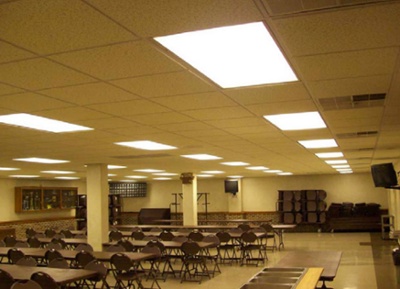
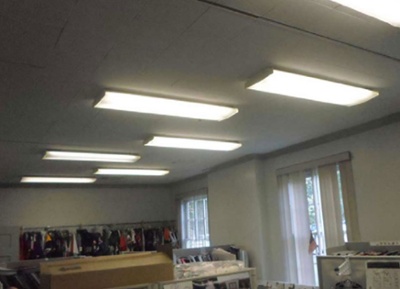
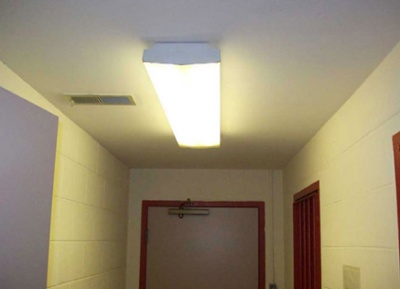
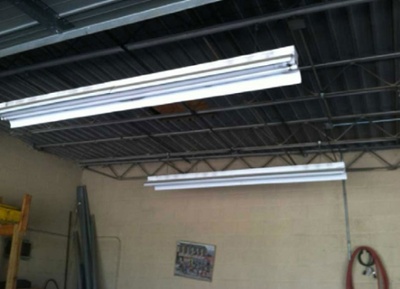
Most existing fluorescent fixtures are installed in recessed troffer, surface mount, vapor tight, or high bay lighting applications. The lamps are classified as either T8 bulbs, T12 bulbs, or T5 bulbs.
Here are some comparison blogs you can read to learn about the differences in these fluorescent lamps and fixtures.
- Lighting Comparison: LED versus HID Lights
- Lighting Comparison: LED vs Metal Halide Lights
- Lighting Comparison: LED vs High Pressure Sodium (HPS) and Low Pressure Sodium (LPS)
Common Issues With Traditional Fluorescent Lights
What are some common issues with conventional fluorescent light fixture applications?
There are several problems with fluorescent lighting. Although the cost of the lamps themselves is very low, maintenance and performance issues often arise over time. Fluorescent lighting is designed to operate for a certain amount of time, each time it is turned on, and thus fluorescent tubes tend to have shorter lifetimes. The more frequently they are activated, the shorter the lifetime of the lamp. Fluorescent lamps are also susceptible to temperature fluctuations and under-perform in colder temperatures.
Energy Costs
For a four foot fluorescent light, tube wattage typically ranges from 28 watts to 40 watts, and an eight foot lamp typically operates at 96 watts. It is common for fluorescent light fixture applications to utilize between two to four lamps per fixture, totaling approximately 160 watts to 112 watts for four foot lamp fixtures and 192 watts for eight foot lamp fixtures. Operating these types of lamps can easily cost up to $200 in electricity costs alone, per fixture, per year.
Maintenance Costs
For fluorescent fixtures, lighting maintenance is very dependent on the operational use of the lamps and fixtures. When operated in cold environments, or operating in a scenario where the lamps are turned on and off frequently, lamp life and performance can degrade drastically in a short period of time. Every time a fluorescent light is tuned on, it degrades the cathodes (the fluorescent lamp ignition system), resulting in a shorter operational life of the lamp. Lifetimes range from 10,000 to 30,000 hours for typical fluorescent tube, and it can easily cost up to $1,545 over the course of three years to maintain the lighting in a space utilizing fluorescent light fixtures.
Lighting Performance
The performance of fluorescent lights can vary based on the TYPE of lamp (T12 bulb, T8 bulb, T5 bulb, etc.). CCT (correlated color temperature) and CRI (color rendering index) can also vary from different manufacturers of these lamps. Ultimately the performance of a fluorescent light fixture degrades significantly over time, and considering that most fluorescent lamps operate in multi-lamp fixtures, what you are left with is an interior lighting fixture whose performance is dependent on how it is operated by an individual user, and the ability of individual components (the lamps and ballasts within the actual fixture) to maintain their peak performance. If a single lamp ceases to function properly within a multi-lamp fixture, the performance of the whole fixture is negatively affected.
Benefits of LED
What are the Benefits of Fluorescent LED Lights?
LED replacements for fluorescent tubes, also described as LED tubes, T8 LED, or LED linear lamps, provide a range of benefits over conventional fluorescent lighting. The way LEDs operate provides inherent advantages over fluorescent light fixtures. The quality of LED fluorescent tube replacements have increased dramatically over the past few years and as a result, LED T8s are adaptable to a wide range of existing fluorescent lighting applications. This adaptability is a key benefit of LED tubes. Often the biggest question when it comes to LED fluorescent replacements is whether to utilize an LED tube within an existing fixture, or to install a new integrated LED fixture. Ultimately that decision is driven by the customer, and their expectations and constraints as they pertain to budget and desired performance.
Energy Savings
Four foot LED tube wattage typically ranges from 12 watts to 20 watts, resulting in a 40%-60% percent reduction in energy consumption. The LED lamp wattage range is so dramatic due to the need to adapt to the many different applications of fluorescent lighting. It is common for indoor LED fluorescent lamp applications to utilize between two and four lamps per fixture. By using LED fluorescent tube replacements in these fixtures, it is possible to save up to $2,692 per year for a room currently using fluorescent light fixtures.
Maintenance Cost Reduction
The way LEDs generate light and progress through their functional life results in a much longer operating life compared to conventional fluorescent light fixtures. Another advantage realized from LED replacements for fluorescent tubes is that they are not negatively affected by cycling (turning on and off), so they are more reliable in scenarios where lighting may be turned on and off frequently.
Lighting Performance
Moving on to the way LED lamps “DISTRIBUTE” light, as a result of the multi-point design, LED fluorescent lamp replacements often provide a very evenly distributed light pattern. The result, in regards to LED versus fluorescent, is a more even foot candle distribution from the LED conversion. In addition to the even distribution of light, LEDs are available in a range of color temperatures, and as a result provide a range of options to increase the visual perception of “brightness."
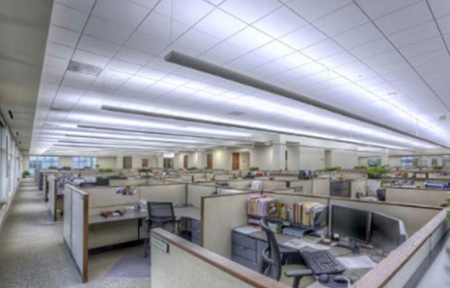
How do I determine what the next step is to improve my fluorescent lighting applications?
The first step is to speak with an LED lighting solutions provider or LED lighting company that is manufacturer-neutral. Why this approach as opposed to the company you may have used for the past several years? Unless that company has a focus on providing LED lamps and light fixtures, it is unlikely that they will have the performance-focused mentality that is required to obtain the desired results of an LED indoor lighting project for your fluorescent light fixture applications. A crucial step in any LED project is understanding that LEDs are NOT a commodity. Prior decades consisted of building facility managers and owners evaluating options for commercial LED lighting, industrial LED lighting, or LED recessed lighting purely on cost, assuming that all of the lighting options in consideration were equal in quality. This is not case with LED fluorescent tube replacement options.
A solution-focused supplier should ask you about your project objectives. Are there budget constraints, energy reduction targets, lighting performance requirements, etc? The appropriate partner will want to get an understanding of your desired OUTCOME, NOT just what specific products they can sell you. Not all LED tube retrofits and conversions for replacing fluorescent lights are created equal. There are different levels of value from different manufacturers for different applications, and by working with a company that has the product expertise to recommend a solution that meets your project priorities, you will ultimately achieve the best results.
Interested In Learning More?
Fill out the form below and one of our lighting specialists will be in touch with you shortly!
